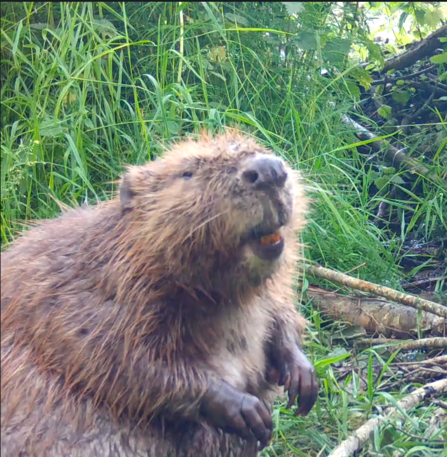
Jo Hackman Photography
Beaver updates
Beavers are known for their accolades as ecosystem engineers. But do you know the key features that make a beaver so well suited to its job and how they actually transform the environment around them to benefit other species?
Over the coming months, we will be highlighting the beaver adaptations that make them so well suited to their watery environment, and allow them to carry out their great engineering feats. We will also be sharing an exclusive glimpse into the Dorset Beaver Project site as it transforms, and the wildlife benefitting from these changes.
Sign up to receive exclusive beaver updates by email below.
Beaver teeth
Beaver teeth at night (https://youtu.be/IoDF8IzMOaA)
Footage showcasing a beaver's teeth and its tree gnawing capabilities at the Dorset Beaver Project site.

Hannah Divine / A beaver showing its teeth at the Dorset Beaver Project site
This week we are starting with something most rodents are well known for, and which are especially important for beavers - their teeth!
Beavers have twenty teeth in total, including four large incisors at the front. A beaver’s teeth are unique in the animal kingdom due to one obvious feature – their colour. A beaver’s teeth are a rusty orange colour due to the high iron levels in the tooth's structure, giving them particularly tough enamel, making them exceptionally strong and durable. In fact, beaver teeth are made mainly of two components – iron and dentine. This structure also gives the beavers another advantage for munching on wood. The dentine is found at the back of the teeth, with the iron at the front. This dentine is softer than the iron front and therefore wears down quicker. This gives beavers' teeth their distinctive and extremely effective chisel-like sharp cutting edge.
Having so much iron in their teeth also makes them resistant against tooth decay – which is vital to beavers given how much they use their teeth. These adaptations give beavers teeth which are unrivalled in shape and strength, just what’s needed when you're chewing on wood all day. Beavers' teeth, like other rodents, are continuously growing so they need to gnaw on wood to keep them the right length and in good condition.
Did you know? A beaver can fell an eight-foot tree in just five minutes!
Beaver teeth - daytime clip (https://youtu.be/43x8a60_DbU)
Footage of a beaver at the Dorset Beaver Project site.
Sign up for beaver updates
Support the Dorset Beaver Project
Watch more of our beavers in action
More about the Dorset Beaver Project
On 8 February 2021, following years of preparation, a pair of beavers (an adult male and female) were released into an enclosed site in west Dorset, having been relocated from Scotland under licence from NatureScot. Since then, the pair have settled well into their new home, having multiple generations of kits, transforming the project site into a wonderful wetland world.
This is a scientific study site and in partnership with the University of Exeter and Wessex Water, we are gathering information on biodiversity and hydrology (water quality and flow) and studying the behaviour and activities of the beavers. We will be making comparisons to the baseline data gathered before they arrived to see how beavers can improve the habitat they occupy and the wider benefits they can potentially bring to the environment in terms of biodiversity, water quality and beneficial effects on river catchments.
Throughout the project, animal welfare has been an absolute priority, so we have ensured that the 4-hectare enclosed site offers enough complex habitat to support the newly expanded beaver family.
Beaver kits
Beaver kit falling off a willow tree. (https://youtu.be/KYIe7Ky31MY)
Steve Oliver / One of the new beaver kits falling off a willow tree whilst trying to feed.
Second generation beaver kit feeding on willow (https://youtu.be/s9DO2Tqtq_Q)
Colleen Smith-Moore / New beaver kit feeding on willow branches in the Dorset Beaver Project site.
First beaver kit born in Dorset (https://youtu.be/8DoqKsoc6RE)
Dorset Wildlife Trust
Beaver dams
Adult beaver caching wood (https://youtu.be/uo5F6hxtxlI)
Adult beaver at the Dorset Beaver Project site caching wood
Beaver maintaining its dam (https://www.youtube.com/watch?v=u7bMlAlSgNw)
Dorset Wildlife Trust / Beaver maintaining its dam
Beavers and other wildlife
Moorhen family and grey heron enjoying the beaver-created wetland. (https://youtu.be/9DkTiBitnRg)
Steve Oliver / Moorhen family and grey heron enjoying the beaver-created wetland.
A beaver charging a polecat at the Dorset Beaver Project site. (https://youtu.be/cXtGnsWZqek)
Dorset Wildlife Trust / A beaver charging a polecat at the Dorset Beaver Project site.
Dorset Wildlife Trust / An otter interacting with two beavers at the Dorset Beaver Project site.
Dorset Wildlife Trust / Weasel family playing in the beaver dam at the Dorset Beaver Project site.
Dorset Beaver Project site video tour
Dorset Beaver Project site video tour (https://youtu.be/MdEJawbJ36A)
Video tour of the Dorset Beaver Project site
Online talk: Dorset Beaver Project with Steve Oliver
Online talk: Dorset Beaver Project (https://youtu.be/lBiQMKCi7cU)
Online talk: Dorset Beaver Project. By Steve Oliver, 29.01.25


